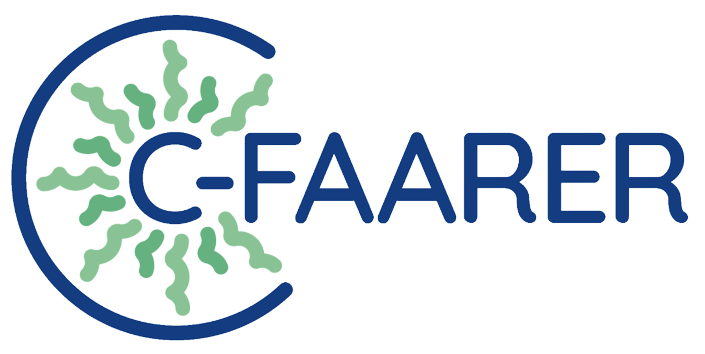Advancing Seaweed Farming: Key Discussions at the Norwegian Embassy in Ireland
On February 28th, the C-FAARER project met with the Norwegian Ambassador to Ireland at the Norwegian Embassy in Dublin, alongside key stakeholders from across the seaweed farming value chain. Both countries have a long history of seaweed trading and this event coincided with 75 years of diplomatic relations between Norway and Ireland. The discussions focused on unlocking the full potential of seaweed farming, addressing regulatory hurdles, investment challenges, site selection issues, and scaling opportunities. Learning from the experience of Norwegian Seaweed Association and its business members, some of whom were present, the rationale and value of the newly formed Irish Seaweed Association (ISA) became clear as an emerging voice for the industry. The event highlighted both the barriers and solutions needed to strengthen Ireland’s role in the global seaweed sector, as well as opportunity for bilateral cooperation.
Challenges
Licensing & Regulatory Barriers
Obtaining a seaweed farming license in Ireland remains a slow and unpredictable process, making it difficult for farmers and investors to plan ahead. Without clear timelines, applicants face uncertainty: When will I get my license? Will my supply chain or customers still be there by then? A best-practice example can be seen in the Netherlands, where applicants receive a holding email, regular updates, and a deadline, ensuring greater transparency. Given the positive environmental impact of seaweed farming—removing excess nutrients and carbon while supporting biodiversity—there is a strong case for accelerating the licensing process for environmentally beneficial regenerative seaweed farming and more clearly demarcating it from finfish-based aquaculture.
Investment & Profitability Gaps
Scaling seaweed farming requires significant investment, but the current market structure presents a high-risk, poor-consistency environment for investors. Many Irish farms hold licenses but choose not to operate due to uncertain profitability and a lack of clear market demand. Over 200 hectares are licensed for seaweed farming in Ireland, yet only a small fraction is actively farmed. Norwegian businesses illustrated how innovation and technology can play a role in making farming operations more efficient and eco-friendlier; however, Irish farmers need a clear path to profitability — without market certainty, investment in infrastructure and scaling remains stagnant.
Farming Zones & Site Selection
The current site selection process lacks structure, as applicants choose their own locations without early-stage consultation. This can lead to conflicts or poor site suitability, damaging the industry's perception. Bord Iascaigh Mhara (BIM) works to engage with applicants early in the process to identify potential conflicts, but currently, there is no requirement for applicants to consult BIM before selecting a site. This can lead to misplaced farms and missed opportunities for better location planning. Another solution could involve environmental studies identifying the best areas for seaweed farming, allowing interested farmers to apply for pre-approved sites. Additionally, an Integrated Multi-Trophic Aquaculture (IMTA) approach, where seaweed farms co-exist with salmon or shellfish farms, could optimize production and environmental benefits. More work is also needed to establish the relationship between Marine Protected Areas (MPAs) and the role of seaweed farms. It is crucial that strategic development of the seaweed farming industry is embedded in the new marine spatial planning framework. The forthcoming EU oceans pact will bring coherence across all EU policy areas linked to oceans and should also guide decision making.
Scaling & Market Demand
One perspective that Norwegian and Irish seaweed farmers agreed on was the need to scale-up and produce larger volumes in order to compete on price and become more competitive. In this context, large buyers in the food and consumer goods sector prioritise cost over sustainability, meaning production must be cost-effective at scale.
In Ireland and Norway, many licensed farms remain dormant due to a lack of large-scale buyers. The discussion explored the question of whether farmers should be vertically integrated (e.g., growing, processing, sales) or specialised in just cultivation, leaving each stage to the experts. Whilst both approaches are valid, it seems more research might be needed to better understand the long-term viability of either approach.
The discussion explored cooperative models to derisk investment in scale-up and secure buyers for their biomass, such as approaches employed by Atlantic Sea Farms and GreenWave in the U.S.
Solutions & Next Steps
Regulatory Improvements & Licensing Reform
A predictable, transparent licensing process is needed to build confidence in the sector. Proposed improvements include:
A holding email and regular updates for applicants
A fixed deadline for decisions to allow farmers to plan ahead
A differentiated approach where seaweed farming permits are streamlined, recognizing their low environmental impact and ecological benefits
Harmonising national licensing arrangements across the EU and other countries that share the Atlantic and Arctic Sea basin
Investment & Market Development
To bridge the gap between small-scale farms and large-scale profitability, investments in technology, cooperative models, and structured supply chains are essential. The Algaebra trading platform, which aims to match producers with buyers, was highlighted as a promising approach providing a marketplace for European countries similar to Greenwave’s platform in the US.
Stronger Collaboration Between Farmers & Processors
Farmers and processors must align harvesting strategies to maximize product value. Farmers often focus on peak biomass, while processors prioritize peak protein and mineral content. A more data-driven, coordinated approach could ensure higher-value products reach the market.
Next Steps
Ireland-Norway Collaboration: Establishing a biannual event to strengthen industry ties.
Stronger Industry Networks: Expanding the role of the Irish Seaweed Association (ISA) and the Norwegian Seaweed Association in connecting farmers, processors, and investors.
Scaling Through Cross-Sector Approaches: Exploring co-located seaweed and aquaculture farms and leveraging offshore wind infrastructure to enable larger-scale production.
Search the Blog….
Visit us on Instagram
















